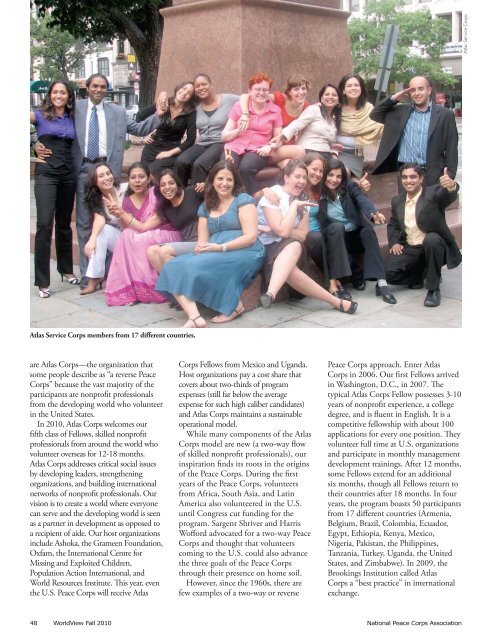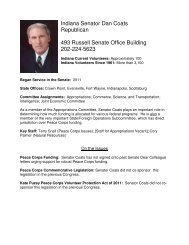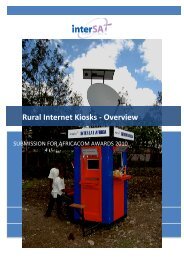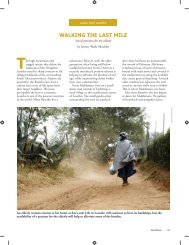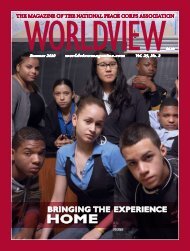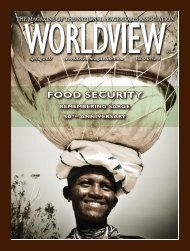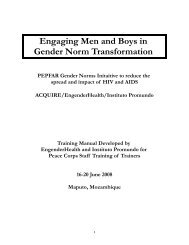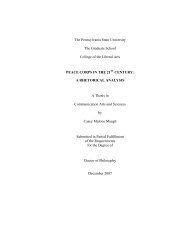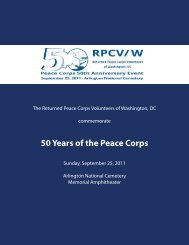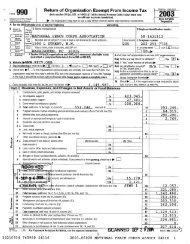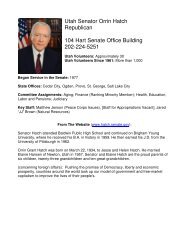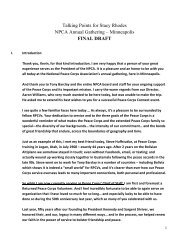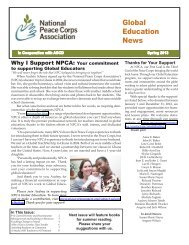Atlas Service <strong>Corps</strong>Atlas Service <strong>Corps</strong> members from 17 different countries.are Atlas <strong>Corps</strong>—the organization thatsome people describe as “a reverse <strong>Peace</strong><strong>Corps</strong>” because the vast majority of theparticipants are nonprofit professionalsfrom the developing world who volunteerin the United States.In <strong>2010</strong>, Atlas <strong>Corps</strong> welcomes ourfifth class of Fellows, skilled nonprofitprofessionals from around the world whovolunteer overseas for 12-18 months.Atlas <strong>Corps</strong> addresses critical social issuesby developing leaders, strengtheningorganizations, and building internationalnetworks of nonprofit professionals. Ourvision is to create a world where everyonecan serve and the developing world is seenas a partner in development as opposed toa recipient of aide. Our host organizationsinclude Ashoka, the Grameen Foundation,Oxfam, the International Centre forMissing and Exploited Children,Population Action International, andWorld Resources Institute. This year, eventhe U.S. <strong>Peace</strong> <strong>Corps</strong> will receive Atlas<strong>Corps</strong> Fellows from Mexico and Uganda.Host organizations pay a cost share thatcovers about two-thirds of programexpenses (still far below the averageexpense for such high caliber candidates)and Atlas <strong>Corps</strong> maintains a sustainableoperational model.While many components of the Atlas<strong>Corps</strong> model are new (a two-way flowof skilled nonprofit professionals), ourinspiration finds its roots in the originsof the <strong>Peace</strong> <strong>Corps</strong>. During the firstyears of the <strong>Peace</strong> <strong>Corps</strong>, volunteersfrom Africa, South Asia, and LatinAmerica also volunteered in the U.S.until Congress cut funding for theprogram. Sargent Shriver and HarrisWofford advocated for a two-way <strong>Peace</strong><strong>Corps</strong> and thought that volunteerscoming to the U.S. could also advancethe three goals of the <strong>Peace</strong> <strong>Corps</strong>through their presence on home soil.However, since the 1960s, there arefew examples of a two-way or reverse<strong>Peace</strong> <strong>Corps</strong> approach. Enter Atlas<strong>Corps</strong> in 2006. Our first Fellows arrivedin Washington, D.C., in 2007. Thetypical Atlas <strong>Corps</strong> Fellow possesses 3-10years of nonprofit experience, a collegedegree, and is fluent in English. It is acompetitive fellowship with about 100applications for every one position. Theyvolunteer full time at U.S. organizationsand participate in monthly managementdevelopment trainings. After 12 months,some Fellows extend for an additionalsix months, though all Fellows return totheir countries after 18 months. In fouryears, the program boasts 50 participantsfrom 17 different countries (Armenia,Belgium, Brazil, Colombia, Ecuador,Egypt, Ethiopia, Kenya, Mexico,Nigeria, Pakistan, the Philippines,Tanzania, Turkey, Uganda, the UnitedStates, and Zimbabwe). In 2009, theBrookings Institution called Atlas<strong>Corps</strong> a “best practice” in internationalexchange.48 WorldView <strong>Fall</strong> <strong>2010</strong> <strong>National</strong> <strong>Peace</strong> <strong>Corps</strong> <strong>Association</strong>
The concept of Atlas <strong>Corps</strong> reallycomes as no surprise to the <strong>Peace</strong><strong>Corps</strong> community. Returned <strong>Peace</strong><strong>Corps</strong> Volunteers realize that theinternational pool of talented peopleis large and that service should not bea one-way flow of ideas, people, andresources. Rather, it should be a twowaypartnership where we all learnfrom and support each other.The best results can be found in thestories of our Fellows. Take for exampleMasoora Ali, a 28-year-old, nonprofitleader from Pakistan. In Islamabad, sheworked with VSO on empowermentof women. As an Atlas <strong>Corps</strong> Fellow,she served at Asian American LEADand helped launch a girls leadershipprogram. Her dedication, commitment,and quality of work resulted in a sixmonthcontract extension, as requestedby her host organization.And what about Maria Duenas? Afterher term of service, TechnoServe invitedher to remain in Washington, althoughpersonal commitments and the structureof the fellowship did not facilitate suchan opportunity. Instead, TechnoServeasked her to help establish a newTechnoServe office in Bogota. Before,Maria helped hundreds of Colombianwomen through entrepreneurship. Now,she reaches thousands of individualsthrough TechnoServe and her Atlas<strong>Corps</strong> experience.Currently, Atlas <strong>Corps</strong> is preparing forour 50 in the 50th campaign—50 Atlas<strong>Corps</strong> Fellows from around the worldvolunteering in the U.S. in the 50thanniversary of the <strong>Peace</strong> <strong>Corps</strong>. It is asmall, yet significant step, in promotinginternational service and positioningthe developing world as a partner indevelopment as opposed to a recipient ofaid. To learn more about this campaignand general Atlas <strong>Corps</strong> activities, pleasevisit www.atlascorps.org.Scott Beale is the Founder and CEOof Atlas <strong>Corps</strong>. Prior to Atlas <strong>Corps</strong>, heserved with the U.S. Department of Statein New Delhi helping coordinate theU.S. Government’s efforts to fight humantrafficking in India. He also worked atAshoka’s Youth Venture, in the WhiteHouse, and with OSCE organizingelections in Bosnia.Exclusive Savings.Without the firewall.Get a free quote today.NPCA members could getan additional discounton car insurance.Some discounts, coverages, payment plans and features are not available in all states or in all GEICO companies. Discount amount varies in some states. One group discountapplicable per policy. Coverage is individual. In New York a premium reduction is available. See geico.com for more details. GEICO and Affiliates. Washington DC 20076. GEICOGecko image © 1999-<strong>2010</strong>.© <strong>2010</strong> GEICOGerman Chancellor FellowshipInternational Opportunity for Young ProfessionalsGermany’s Alexander von Humboldt Foundation awards ten German ChancellorFellowships annually to young professionals in the private, public, not-for-profit,cultural and academic sectors who are citizens of the United States. Theprogram, which also includes fellowships for citizens of the Russian Federationand the People’s Republic of China, sponsors individuals who demonstrate thepotential to strengthen ties between Germany and their own country through theirprofession or studies. The fellowship provides for a stay of one year in Germanyfor professional development, study, or research. Prior knowledge of German isnot a prerequisite.The program begins September 1 and lasts twelve months. It is preceded bythree months of intensive language classes in Germany. Must be a U.S., Russianor Chinese citizen. A bachelor’s degree is required. Candidates must havereceived their degree after September 1, 1999. Application deadline for U.S.applicants: October 15, <strong>2010</strong>. Applications and information available at:www.humboldt-foundation.deinfo@americanfriends-of-avh.org – (202) 783-1907Economics ● Environmental Affairs ● Finance ● GovernmentJournalism ● Law ● Management ● Public Policywww.<strong>Peace</strong><strong>Corps</strong>Connect.org WorldView <strong>Fall</strong> <strong>2010</strong> 49


